This site uses cookies as defined in our Cookie Policy, by continuing to use this site you agree to their use.
Continue
| Arrive | Depart | ||||||
| 14th14 | NovNov | 202525 | Beijing, China, embark on the Viking Yi Dun | 08:00 | 18:00 | ||
| 15th15 | NovNov | 202525 | Dalian, China | 10:00 | 18:00 | ||
| 16th16 | NovNov | 202525 | Qingdao, China | 14:00 | 23:00 | ||
| 17th17 | NovNov | 202525 | At Sea | ||||
| 18th18 | NovNov | 202525 | Shanghai, China | 08:00 | 23:00 | ||
Shanghai is a city of two faces. It is home to some of the world’s tallest skyscrapers, miles of luxury goods shops, and scores of trendy bars and restaurants. But look just beyond the main streets and you’ll find narrow alleyways packed with traditional lane houses, where laundry billows from bamboo poles, and local communities are alive and well.Shanghai has always been China’s most Westernized city. In its heyday, Shanghai had the best nightlife, the greatest architecture, and the strongest business in Asia. Nearly a century later, after extreme tumult and political upheaval, it’s back on top.Shanghai’s charm lies not in a list of must-see sites, but in quiet, tree-lined streets, the Bund’s majestic colonial buildings, sweet boutiques, and a dizzying array of places to eat and drink, from literal hole-in-the-walls to celebrity chef restaurants.Today, Shanghai has nearly 24 million people, the skyscrapers keep getting taller, the metro keeps getting longer, and the historical buildings continue to evade the wrecking ball. For how much longer is anyone’s guess. | |||||||
| 19th19 | NovNov | 202525 | At Sea | ||||
| 20th20 | NovNov | 202525 | Jeju Island, South Korea | 08:00 | 16:00 | ||
| 21st21 | NovNov | 202525 | Hiroshima, Japan | 15:15 | |||
History buffs will want to write home Hiroshima. Despite being devastated in 1945, this Japanese city is known to all for its commitment peace – its ruin on the 6th August 1945 led to the end of the war and today, the Peace Memorial (a UNESCO World Heritage Site) , is a constant reminder of the destruction that war brings. A walk in the leafy boulevards of Peace Memorial Park brings quiet contemplation. The Flames of Peace – set in the park’s central feature pond – burn brightly and will continue to do so until all the nuclear bombs I the world have been destroyed. There are many other inspiring messages of hope around the city too; the Children’s’ Peace Monument just north of the park is a homage to little Sadako Sasaki, who was just two in 1945. When she developed leukemia in 1956, she believed that if she folded 1,000 paper cranes – a symbol of longevity and happiness in Japan – she would recover. Sadly she died before she finished her task but her classmates finished the rest. It is impossible to ignore the events of 1945 in Hiroshima, but this is far from a depressing place. The great efforts that have been made in rebuilding of the city over the years have given Hiroshima a vibrant, eclectic edge, with the downtown shopping area and street food stalls being well worth a visit. The proximity to Miyajima and its iconic, impressive, Torii gate should not be overlooked either. If you are lucky enough to visit during the unpredictable and short-lived Sakura (cherry blossom) season, then the extraordinary sight of the delicate pink blossom floating across the water to the red gate, means you can consider yourself one of the luckiest people on the planet. | |||||||
| 22nd22 | NovNov | 202525 | Hiroshima, Japan | 18:00 | |||
History buffs will want to write home Hiroshima. Despite being devastated in 1945, this Japanese city is known to all for its commitment peace – its ruin on the 6th August 1945 led to the end of the war and today, the Peace Memorial (a UNESCO World Heritage Site) , is a constant reminder of the destruction that war brings. A walk in the leafy boulevards of Peace Memorial Park brings quiet contemplation. The Flames of Peace – set in the park’s central feature pond – burn brightly and will continue to do so until all the nuclear bombs I the world have been destroyed. There are many other inspiring messages of hope around the city too; the Children’s’ Peace Monument just north of the park is a homage to little Sadako Sasaki, who was just two in 1945. When she developed leukemia in 1956, she believed that if she folded 1,000 paper cranes – a symbol of longevity and happiness in Japan – she would recover. Sadly she died before she finished her task but her classmates finished the rest. It is impossible to ignore the events of 1945 in Hiroshima, but this is far from a depressing place. The great efforts that have been made in rebuilding of the city over the years have given Hiroshima a vibrant, eclectic edge, with the downtown shopping area and street food stalls being well worth a visit. The proximity to Miyajima and its iconic, impressive, Torii gate should not be overlooked either. If you are lucky enough to visit during the unpredictable and short-lived Sakura (cherry blossom) season, then the extraordinary sight of the delicate pink blossom floating across the water to the red gate, means you can consider yourself one of the luckiest people on the planet. | |||||||
| 23rd23 | NovNov | 202525 | Miyazaki, Japan | 09:00 | 18:00 | ||
| 24th24 | NovNov | 202525 | Kochi, Japan | 08:00 | 18:00 | ||
| 25th25 | NovNov | 202525 | Kobe, Japan | 08:00 | |||
Located on the calm waters of the Inland Sea, Kobe has served as an important port town for hundreds of years. It was one of the first harbours to accept foreign traders in 1868 when Japan was just emerging from its centuries of isolation. What followed was a surge of Western trade and exports. Today, Kobe is quite multicultural, with expatriates from 98 different nations in residence, providing a cultural diversity most easily visible in restaurants serving every kind of cuisine, including the now world famous Kobe beef. The Great Hanshin Earthquake of 1995 set back Kobe’s development, but not for long. Kobe emerged more vibrant than before - with additional attractions, hotels and urban redevelopment, and only a few remnants of the extensive damage. It is a cosmopolitan place with lively shopping arcades, interesting museums, great restaurants, and a port that is still at the heart of things. Kobe is well known for its nightlife, in an intimate quarter of neon lights, cosy bars and sophisticated nightclubs. It also serves as the gateway to the ancient Japanese capitals of Kyoto and Nara. | |||||||
| 26th26 | NovNov | 202525 | Kobe, Japan | 13:00 | |||
Located on the calm waters of the Inland Sea, Kobe has served as an important port town for hundreds of years. It was one of the first harbours to accept foreign traders in 1868 when Japan was just emerging from its centuries of isolation. What followed was a surge of Western trade and exports. Today, Kobe is quite multicultural, with expatriates from 98 different nations in residence, providing a cultural diversity most easily visible in restaurants serving every kind of cuisine, including the now world famous Kobe beef. The Great Hanshin Earthquake of 1995 set back Kobe’s development, but not for long. Kobe emerged more vibrant than before - with additional attractions, hotels and urban redevelopment, and only a few remnants of the extensive damage. It is a cosmopolitan place with lively shopping arcades, interesting museums, great restaurants, and a port that is still at the heart of things. Kobe is well known for its nightlife, in an intimate quarter of neon lights, cosy bars and sophisticated nightclubs. It also serves as the gateway to the ancient Japanese capitals of Kyoto and Nara. | |||||||
| 27th27 | NovNov | 202525 | Shimizu, Japan | 09:00 | 19:00 | ||
The salt and pepper cone of Japan's most famous natural landmark won’t fail to take your breath away, as it soars into the sky in a vision of spectacular symmetry. Make sure your camera is fully prepared before you dock in Shimizu’s port, where unparalleled views of the extraordinary Mount Fuji’s dramatic peak await. Take your time to soak up one of Japan's most iconic views, before dipping your toes into the rest of what this destination of tranquil temples has to offer. While there’s a bustling fish market, and a charming amusement park waiting close to the port, most new arrivals immediately set off in pursuit of the best views of Mount Fuji, or to see the stunning panorama on offer from the heights of the Kunozan Toshogu Shrine. Take the cable car up to the top, to experience the tranquillity around the forested shrine, and to enjoy its stunning architecture of deep scarlets and gleaming golds. You can also enjoy heart-stopping views out over the Bay of Suruga, and the tea plantations below. | |||||||
| 28th28 | NovNov | 202525 | Yokohama, Japan, disembark the Viking Yi Dun | 06:00 | |||
In 1853, a fleet of four American warships under Commodore Matthew Perry sailed into the bay of Tokyo (then Edo) and presented the reluctant Japanese with the demands of the U.S. government for the opening of diplomatic and commercial relations. The following year Perry returned and first set foot on Japanese soil at Yokohama—then a small fishing village on the mudflats of Tokyo bay. Two years later New York businessman Townsend Harris became America's first diplomatic representative to Japan. In 1858 he was finally able to negotiate a commercial treaty between the two countries; part of the deal designated four locations—one of them Yokohama—as treaty ports. In 1859 the shogunate created a special settlement in Yokohama for the growing community of merchants, traders, missionaries, and other assorted adventurers drawn to this exotic new land of opportunity. The foreigners (predominantly Chinese and British, plus a few French, Americans, and Dutch) were confined here to a guarded compound about 5 square km (2 square miles)—placed, in effect, in isolation—but not for long. Within a few short years the shogunal government collapsed, and Japan began to modernize. Western ideas were welcomed, as were Western goods, and the little treaty port became Japan's principal gateway to the outside world. In 1872 Japan's first railway was built, linking Yokohama and Tokyo. In 1889 Yokohama became a city; by then the population had grown to some 120,000. As the city prospered, so did the international community and by the early 1900s Yokohama was the busiest and most modern center of international trade in all of East Asia. Then Yokohama came tumbling down. On September 1, 1923, the Great Kanto Earthquake devastated the city. The ensuing fires destroyed some 60,000 homes and took more than 40,000 lives. During the six years it took to rebuild the city, many foreign businesses took up quarters elsewhere, primarily in Kobe and Osaka, and did not return. Over the next 20 years Yokohama continued to grow as an industrial center—until May 29, 1945, when in a span of four hours, some 500 American B-29 bombers leveled nearly half the city and left more than half a million people homeless. When the war ended, what remained became—in effect—the center of the Allied occupation. General Douglas MacArthur set up headquarters here, briefly, before moving to Tokyo; the entire port facility and about a quarter of the city remained in the hands of the U.S. military throughout the 1950s. By the 1970s Yokohama was once more rising from the debris; in 1978 it surpassed Osaka as the nation's second-largest city, and the population is now inching up to the 3.5 million mark. Boosted by Japan's postwar economic miracle, Yokohama has extended its urban sprawl north to Tokyo and south to Kamakura—in the process creating a whole new subcenter around the Shinkansen Station at Shin-Yokohama. The development of air travel and the competition from other ports have changed the city's role in Japan's economy. The great liners that once docked at Yokohama's piers are now but a memory, kept alive by a museum ship and the occasional visit of a luxury vessel on a Pacific cruise. Modern Large as Yokohama is, the central area is very negotiable. As with any other port city, much of what it has to offer centers on the waterfront—in this case, on the west side of Tokyo Bay. The downtown area is called Kannai (literally, "within the checkpoint"); this is where the international community was originally confined by the shogunate. Though the center of interest has expanded to include the waterfront and Ishikawa-cho, to the south, Kannai remains the heart of town. Think of that heart as two adjacent areas. One is the old district of Kannai, bounded by Basha-michi on the northwest and Nippon-odori on the southeast, the Keihin Tohoku Line tracks on the southwest, and the waterfront on the northeast. This area contains the business offices of modern Yokohama. The other area extends southeast from Nippon-odori to the Moto-machi shopping street and the International Cemetery, bordered by Yamashita Koen and the waterfront to the northeast; in the center is Chinatown, with Ishikawa-cho Station to the southwest. This is the most interesting part of town for tourists. Whether you're coming from Tokyo, Nagoya, or Kamakura, make Ishikawa-cho Station your starting point. Take the South Exit from the station and head in the direction of the waterfront. | |||||||
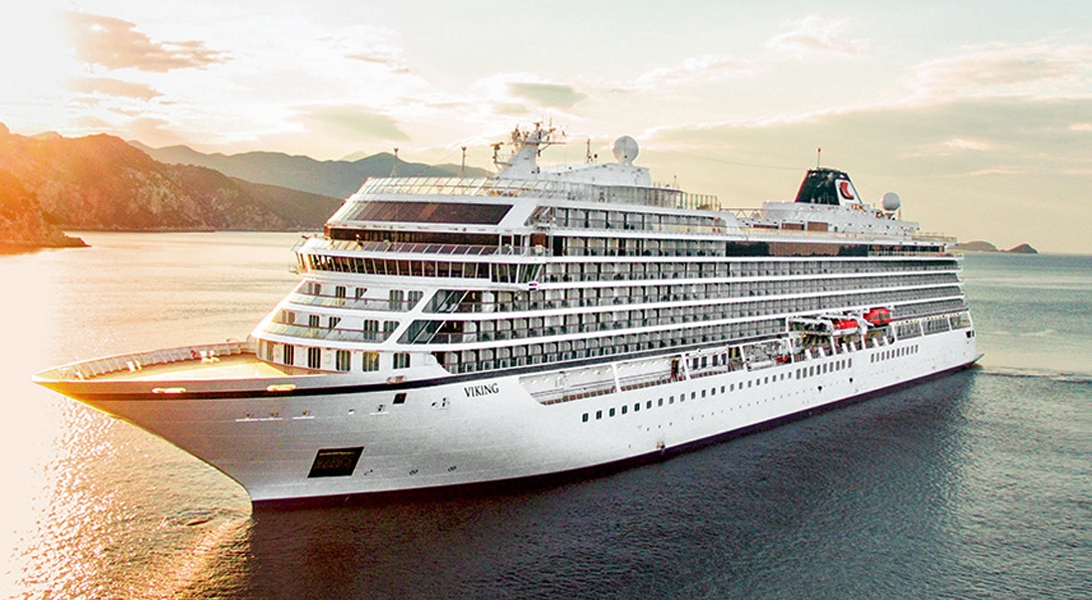










The images shown are for illustration purposes only and may not be an exact representation of what you find on the ship.
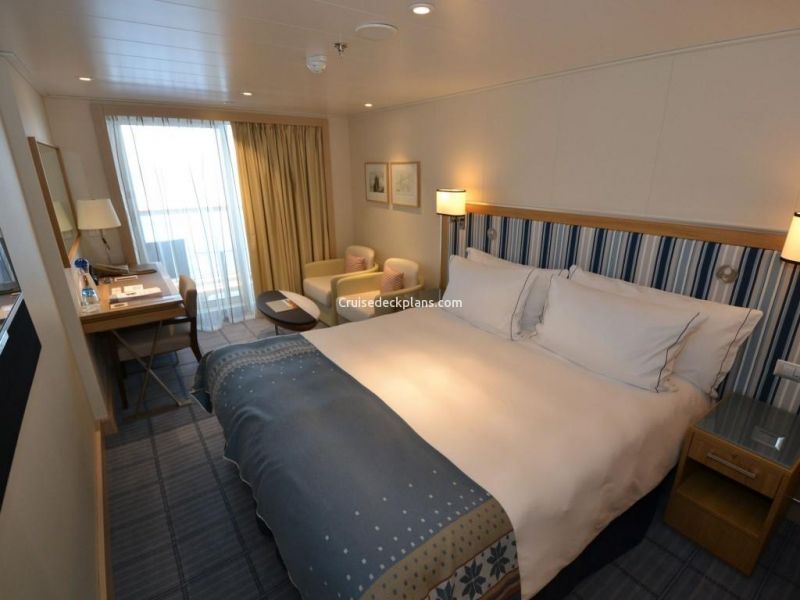
| Grade Code | From | To | |
| DV6 | Deluxe Veranda | £6,790 | £6,790 |
| DV5 | Deluxe Veranda | £6,990 | £6,990 |
| DV4 | Deluxe Veranda | £7,190 | £7,190 |
| DV3 | Deluxe Veranda | £7,390 | £7,390 |
| DV2 | Deluxe Veranda | £7,590 | £7,590 |
| DV1 | Deluxe Veranda | £7,790 | £7,790 |
Treat yourself to the little extras that make a big difference. Our Deluxe Veranda Stateroom is the same size as the Veranda Stateroom and offers the same features, as well as a mini-bar of soft drinks, water and snacks that is replenished daily. In-suite binoculars, a coffee maker and luxurious cashmere blanket all add to the pleasure. You can also look forward to priority room availability from 2pm, and preferred choice for dining, with priority reservations in the main dining room 60 days prior to departure, as well as one guaranteed reservation in each speciality restaurant
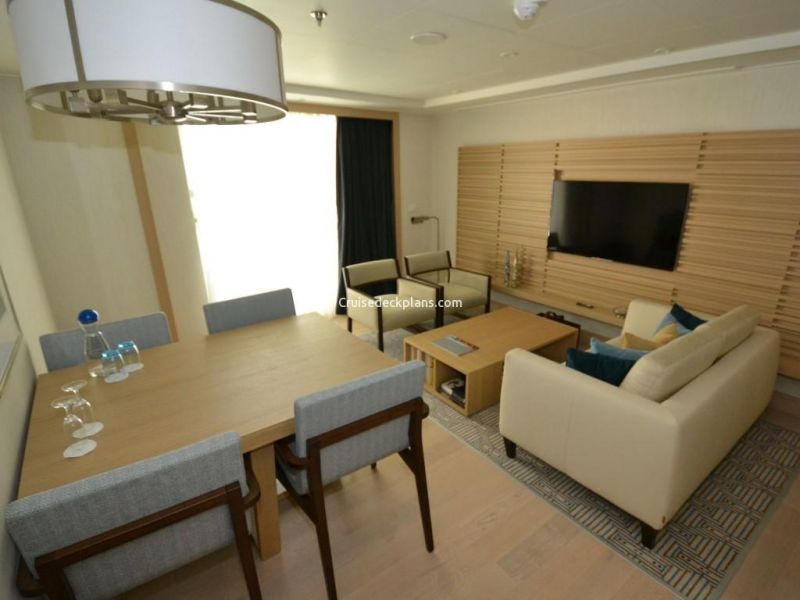
| Grade Code | From | To | |
| ES3 | Explorer Suite | £12,990 | £12,990 |
| ES2 | Explorer Suite | £13,690 | £13,690 |
| ES1 | Explorer Suite | £15,190 | £15,190 |
From 757 to 1,163 sq. ft., Explorer Suites are perfect if you want to push the boat out. Viking's most spacious and luxurious accommodation, these suites feature a large wraparound veranda to take in the incredible views. You can look forward to all the inclusions of the previously mentioned staterooms as well as priority main dining room reservations 90 days before departure, and three guaranteed reservations in each speciality restaurant. There are just 14 Explorer Suites, and it is advised that you book yours early.
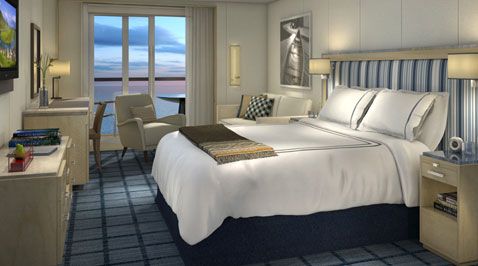
| Grade Code | From | To | |
| OS | Owner's Suite | £19,990 | £19,990 |
Unique and exclusive, the lavish Owner’s Suite is, quite simply, the best accommodation onboard. An incredible 1,448 sq. ft. it offers one-of-a-kind features personally selected by Torstein Hagen, including his favourite wines and recommended reads. As a guest in the Owner’s Suite you will want for nothing.
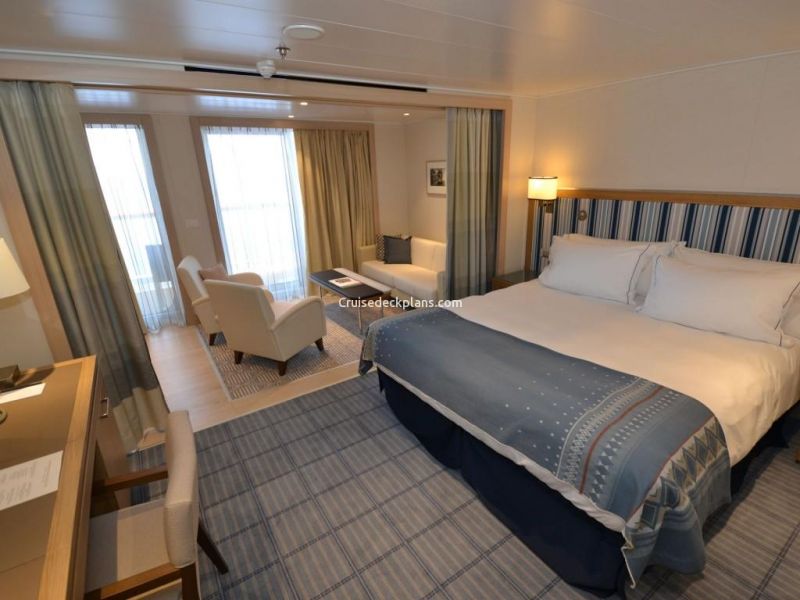
| Grade Code | From | To | |
| PS3 | Penthouse Junior Suite | £9,990 | £9,990 |
| PS2 | Penthouse Junior Suite | £10,390 | £10,390 |
| PS1 | Penthouse Junior Suite | £10,790 | £10,790 |
Looking for even more space and more treats? At 405 sq. ft. these lovely suites boast all the inclusions of the previously mentioned staterooms. You can also look forward to a welcome bottle of Champagne, and complimentary dry cleaning and laundry service. And you can settle in to your room earlier at 11am, and enjoy priority reservations in the main dining room 80 days prior to departure, as well as three guaranteed reservations in each speciality restaurant. There are only 32 suites in this category, so be sure to reserve yours soon.
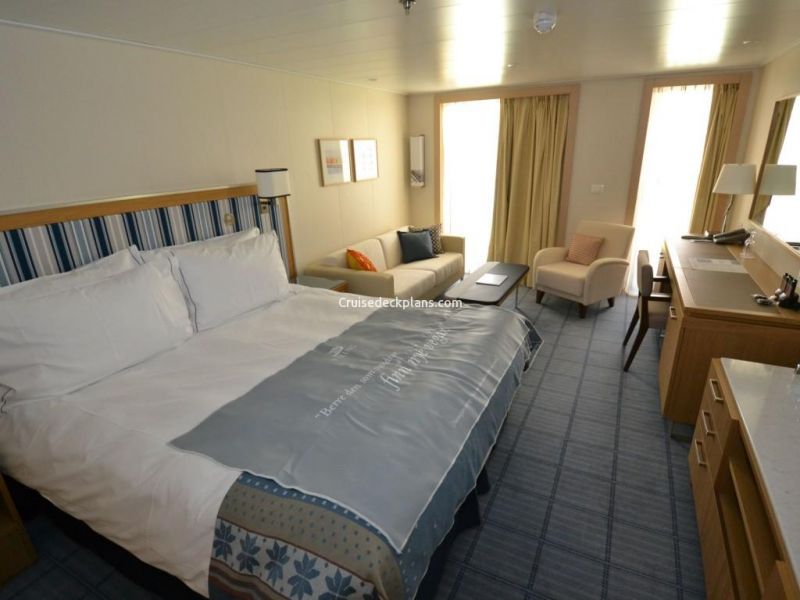
| Grade Code | From | To | |
| PV3 | Penthouse Veranda | £7,990 | £7,990 |
| PV2 | Penthouse Veranda | £8,190 | £8,190 |
| PV1 | Penthouse Veranda | £8,390 | £8,390 |
If you like a little more space, our Penthouse Veranda is even larger at 338 sq. ft. and features a generous sitting area. You’ll enjoy even more extras, including a mini bar with alcoholic drinks, soft drinks, water and snacks that is restocked daily, and complimentary shoe shine and pressing service. Your room will be available from 1pm, and you’ll enjoy priority reservations in the main dining room 70 days before departure, as well as two guaranteed reservations in each speciality restaurant, also 70 days before departure.
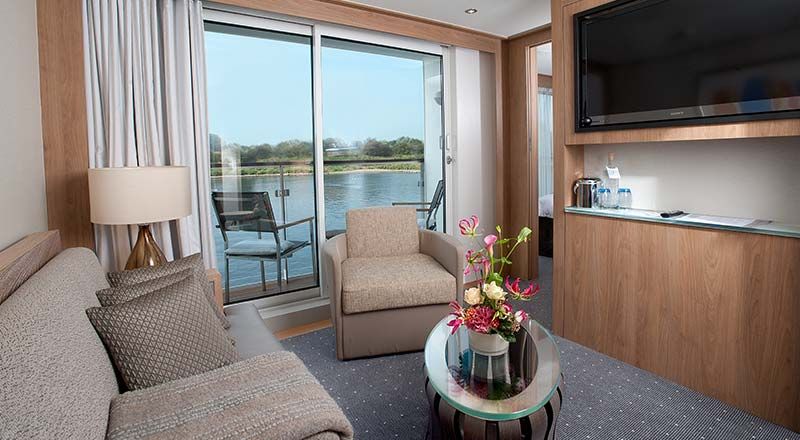
| Grade Code | From | To | |
| V2 | Veranda | £6,490 | £6,490 |
| V1 | Veranda | £6,690 | £6,690 |
Relax in our welcoming and comfortable Veranda Stateroom. At 270 sq. ft. including a 46 sq. ft. veranda, it is wonderfully spacious and inviting. This stateroom features a king-size bed with luxury linens, and a beautifully appointed ensuite with heated floor and indulgent toiletries. Your host of complimentary extras includes soft robes and slippers, flat- screen TV with movies on demand, 24-hour room service, and Wi-Fi. You can check in from 3pm.
The images shown are for illustration purposes only and may not be an exact representation of what you find on the ship.
The images shown are for illustration purposes only and may not be an exact representation of what you find on the ship.
The images shown are for illustration purposes only and may not be an exact representation of what you find on the ship.
The images shown are for illustration purposes only and may not be an exact representation of what you find on the ship.
| 14 nights aboard the Viking Yi Dun | |||
| Deluxe all-veranda accommodation | |||
| Wine, beer and soft drinks with all meals on-board | |||
| Enriched escorted tours with guide and headsets | |||
| Complimentary self-service laundry | |||
| Complimentary speciality restaurants | |||
| Complimentary tea and coffee | |||
| Port Taxes and Fees | |||
 | ABTA and ATOL Protection* | ||
Date 14th Nov 2025 |
Nts 14 |
Balcony £6,490pp |
Suite £7,990pp |
Date 14th Nov 2025 |
Nts 14 |
Balcony £6,490pp |
Suite £7,990pp |
| Balcony staterooms from | £6,490pp | ||
| DV1 | Deluxe Veranda |  | |
| DV2 | Deluxe Veranda |  | |
| DV3 | Deluxe Veranda | £7,390pp | |
| DV4 | Deluxe Veranda | £7,190pp | |
| DV5 | Deluxe Veranda |  | |
| DV6 | Deluxe Veranda | £6,790pp | |
| V1 | Veranda |  | |
| V2 | Veranda | £6,490pp | |
| Suite staterooms from | £7,990pp | ||
| OS | Owner's Suite | £19,990pp | |
| ES1 | Explorer Suite | £15,190pp | |
| ES2 | Explorer Suite | £13,690pp | |
| ES3 | Explorer Suite | £12,990pp | |
| PS1 | Penthouse Junior Suite | £10,790pp | |
| PS2 | Penthouse Junior Suite | £10,390pp | |
| PS3 | Penthouse Junior Suite | £9,990pp | |
| PV1 | Penthouse Veranda | £8,390pp | |
| PV3 | Penthouse Veranda | £7,990pp | |
| PV2 | Penthouse Veranda | £8,190pp | |
Fusion Cruises when selling travel arrangements is a trading name of The Midcounties Co-operative Ltd. Fusion Cruises is an Accredited Body Member of Midcounties Co-operative Travel Consortium. (ABTA:P6652, ATOL:6053).
Book with Confidence. We are a Member of ABTA which means you have the benefit of ABTA’s assistance and Code of Conduct.
Some of the flights and flight-inclusive holidays on this website are financially protected by the ATOL scheme but ATOL protection does not apply to all holiday and travel services offered on this website. This website will provide you with information on the protection that applies in the case of each holiday and travel service offered before you make your booking. If you do not receive an ATOL Certificate then the booking will not be ATOL protected. If you do receive an ATOL Certificate but all parts of your trip are not listed on it, those parts will not be ATOL protected. Please see our booking conditions for information, or for more information about financial protection and the ATOL Certificate go to: www.caa.co.uk
